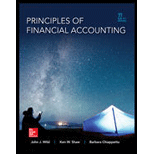
1.
Determine the break-even point in both sales units and sales dollars of each individual product when the Company P continuous to use old material.
1.
Explanation of Solution
Break-Even Point: It is the point of sales at which entity neither earns a profit nor suffers a loss. It can also be said that the point of sales at which sales value of the entity recovers the entire cost of fixed and variable nature is called break-even point.
Determine the break-even point in composite units.
Given, fixed costs are $250,000 and contribution margin per composite unit is $122 (working note 1).
Compute the break-even in individual product unit sales:
| Unit sales of Red at break-even: | 2,050 units @ 5 units | 10,250 units |
| Unit sales of White at break-even | 2,050 units @ 4 units | 8,200 units |
| Unit sales of Blue at break-even | 2,050 units @ 2 units | 4,100 units |
Table (1)
Compute the break-even in individual product dollar sales:
| Dollar sales of Red at break-even: | 10,250 units @$20 | $205,000 |
| Dollar sales of White at break-even | 8,200 units @$35 | $287,000 |
| Dollar sales of Blue at break-even | 4,100 units @$65 | $266,500 |
| Total | $768,265 |
Table (2)
Working note (1): Calculate contribution margin per unit.
Selling price per composite unit is $370 (working note 2) and variable cost per composite unit is $248(working note 3).
Working note (2): Calculate the selling price per composite unit
| 5 units of Red @ $20 each | $100 |
| 4 units of White @ $35 each | 140 |
| 2 units of Blue @ $65 each | 130 |
| Selling price per composite unit | $370 |
Table (3)
Working note (3): Calculate the variable costs per composite unit.
| 5 units of Red @ $12 each | $60 |
| 4 units of White @ $22 each | 88 |
| 2 units of Blue @ $50 each | 100 |
| Variable costs per composite unit | $248 |
Table (4)
Therefore, the break-even point is 2,050 composite units at $768,265 when the Company P continuous to use old material.
2.
Determine the break-even point in both sales units and sales dollars of each individual product when the Company P continuous to use new material.
2.
Explanation of Solution
Break-Even Point: It is the point of sales at which entity neither earns a profit nor suffers a loss. It can also be said that the point of sales at which sales value of the entity recovers the entire cost of fixed and variable nature is called break-even point.
Determine the break-even point in composite units.
Given, fixed costs are $300,000
Compute the break-even in individual product unit sales:
| Unit sales of Red at break-even: | 1,364 units @ 5 units | 6,820 units |
| Unit sales of White at break-even | 1,364 units @ 4 units | 5,456 units |
| Unit sales of Blue at break-even | 1,364 units @ 2 units | 2,728 units |
Table (5)
Compute the break-even in individual product dollar sales:
| Dollar sales of Red at break-even: | 6,820 units @$20 | $136,400 |
| Dollar sales of White at break-even | 5,456 units @$35 | $190,960 |
| Dollar sales of Blue at break-even | 2,728 units @$65 | $177,320 |
| Total | $504,680 |
Table (6)
Working note (4): Calculate contribution margin per unit.
Selling price per composite unit is $370 (working note 2) and variable cost per composite unit is $150(working note 5).
Working note (5): Calculate the variable costs per composite unit.
| 5 units of Red @ $ $6 each | $30 |
| 4 units of White @ $10 each | 40 |
| 2 units of Blue @ $40 each | 80 |
| Variable costs per composite unit | $150 |
Table (7)
Therefore, the break-even point is 1,364 composite units at $504,680 when the Company P continuous to use new material.
3.
Explain the way the above analysis will offer the management for long-term planning.
3.
Explanation of Solution
If the business invests in the fixed assets like plant and machinery, then there is an increase in the risk levels that is the business needs to recover more fixed costs. But, the investments in fixed assets will lower the variable costs which lowers break-even point, this will making business easier to make a profit with fewer sales.
Want to see more full solutions like this?
Chapter 21 Solutions
Principles of Finan. Accounting, Chapter 1-17 (Loose)

 AccountingAccountingISBN:9781337272094Author:WARREN, Carl S., Reeve, James M., Duchac, Jonathan E.Publisher:Cengage Learning,
AccountingAccountingISBN:9781337272094Author:WARREN, Carl S., Reeve, James M., Duchac, Jonathan E.Publisher:Cengage Learning, Accounting Information SystemsAccountingISBN:9781337619202Author:Hall, James A.Publisher:Cengage Learning,
Accounting Information SystemsAccountingISBN:9781337619202Author:Hall, James A.Publisher:Cengage Learning, Horngren's Cost Accounting: A Managerial Emphasis...AccountingISBN:9780134475585Author:Srikant M. Datar, Madhav V. RajanPublisher:PEARSON
Horngren's Cost Accounting: A Managerial Emphasis...AccountingISBN:9780134475585Author:Srikant M. Datar, Madhav V. RajanPublisher:PEARSON Intermediate AccountingAccountingISBN:9781259722660Author:J. David Spiceland, Mark W. Nelson, Wayne M ThomasPublisher:McGraw-Hill Education
Intermediate AccountingAccountingISBN:9781259722660Author:J. David Spiceland, Mark W. Nelson, Wayne M ThomasPublisher:McGraw-Hill Education Financial and Managerial AccountingAccountingISBN:9781259726705Author:John J Wild, Ken W. Shaw, Barbara Chiappetta Fundamental Accounting PrinciplesPublisher:McGraw-Hill Education
Financial and Managerial AccountingAccountingISBN:9781259726705Author:John J Wild, Ken W. Shaw, Barbara Chiappetta Fundamental Accounting PrinciplesPublisher:McGraw-Hill Education





